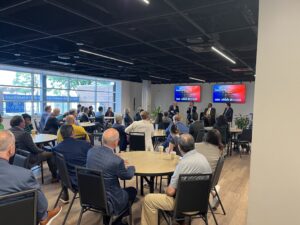As the world slowly emerges from the pandemic, communities and companies are now asking: why and where is talent relocating?
To answer this question, DCI surveyed 1,000 working-age people across the U.S. who recently relocated at least 100 miles from their previous residence to learn what persuaded them to pick up their lives and move. What the research showed was that a large majority of people were simply looking for a better quality of life after time to sit and reflect these past few years.
In its sixth edition, the Talent Wars report sets out each year to better understand how to attract, and ultimately retain, talent. While many familiar trends from previous years were identified in this iteration, some new shifts in relation to travel and tourism were revealed, underscoring the importance of economic development and destination marketing organizations collaborating on talent attraction efforts.
Below are five of the top takeaways from the report, which can be downloaded here.
1. TALENT IS INCREASINGLY UNWILLING TO SACRIFICE THEIR QUALITY OF LIFE FOR A JOB
With time to reflect, talent is reprioritizing what they want out of jobs and locations. With opportunities expanding due to more jobs than people to fill them as well as the rise in remote work, talent is no longer tied to a physical office which gives them the freedom to weigh factors differently. There has never been a time where talent has had as much flexibility and control in choosing not just a job but also a lifestyle.
Thinking back to the funnel analogy, data show that people are initially being driven to consider relocation by the opportunity for a better quality of life or a different lifestyle. While talent will not relocate without being able to afford to live comfortably in a location, the importance of showcasing an area’s livability assets has never been so important. Reaching talent at the top of the funnel and painting the picture of how talent could have an improved quality of life in your location, while still addressing the more practical factors such as cost of living and the housing market will set your community up for success.
2. THE CURRENT ENVIRONMENT HAS LEVELED THE PLAYING FIELD… SMALL AND MID-SIZE COMMUNITIES CAN NOW COMPETE BECAUSE OF HOW PEOPLE WANT TO WORK AND HOW EMPLOYERS ARE MEETING THESE DEMANDS
Small and mid-sized communities have more opportunities to capture relocating talent than ever before. Data show that talent is moving to different types of communities in search of new lifestyles or perhaps to improve their standard of living. The time is right for these communities to market themselves and make sure they are differentiating themselves.
In many cases, small and mid-sized communities can compete particularly when it comes to the cost of living. It is vital, however, that the proper infrastructure (i.e., high-speed internet) to support remote workers is in place to successfully attract and retain this mobile workforce.
3. FOR A TALENT MARKETING PROGRAM TO BE SUCCESSFUL, YOUR TOURISM STAKEHOLDERS MUST BE AT THE TABLE
We know that often the first introduction to a community is through visiting and creating that first, positive impression is critical to moving people down the funnel towards relocation. It’s important to remember that while visitors are in a location, clear messaging on livability and job-related assets in the destination will begin to plant the seed of what it would be like for someone to not only visit a location, but live and work there as well. This year’s data also show that 52% of talent reports visiting a state and/or local tourism website when considering relocation. It is critical to promote a destination’s public image via this channel as a good place not just to visit but also as a place to live and work.
Tourism organizations are uniquely qualified to offer this perspective. If communities are not leveraging that opportunity, they are missing out.
4. COMMUNITIES NEED TO PUT MONEY WHERE THEIR MOUTH IS AND ENGAGE EXISTING RESIDENTS IN THE BATTLE
Talent attraction marketing requires resources. It’s not just enough to talk about talent shortages but to also dedicate organizational time and financial resources. By not working with your tourism counterparts or other workforce stakeholders, you are leaving money on the table and run the risk of duplicating efforts.
Internet research is the top influencer in forming perceptions of a community. The internet is also an aggregator of information and it’s critical that a community monitor and make sure that what is being said online is putting your community in the best possible light. A well-designed website, engaging social influencers and a strong earned media campaign are just a few tools that will help your community stand out. Creating positive resident sentiment is also critical as existing residents will be your best ambassadors and 50% of talent report “word of mouth” is a key influencer in forming perceptions of a location. Arming your existing residents with key messaging is a critical—and often overlooked—step in advancing an area’s talent attraction program.
5. WORKPLACE MODELS NEED TO ADAPT TO CHANGING TIMES
Until this point, DCI’s research and findings have been focused on the community level and how to best market to talent in collaboration with other key stakeholders. The role of employers in this process cannot be overlooked and it must be recognized that the old 9-5, on-site job will not be coming back for many industries, and employers must adapt accordingly. Even for those industries that require workers to be in person, such as many in the hospitality industry, need to rethink how they are letting employees work and how to maximize the likelihood of attracting and retaining workers. Working with employers to implement new workplace models such as the “parent shift” (9 am to 2 pm) or the “fireman/firewoman shift” (four days on/ three days off) could potentially help alleviate some of the talent shortages felt by companies. Helping companies brainstorm these “next practices” and then showcasing how companies in the community are working differently can be one more tool in your marketing arsenal for talent.
Download the entire report, here.
View DCI’s proven results and case studies and learn more about their talent attraction marketing services, here.











